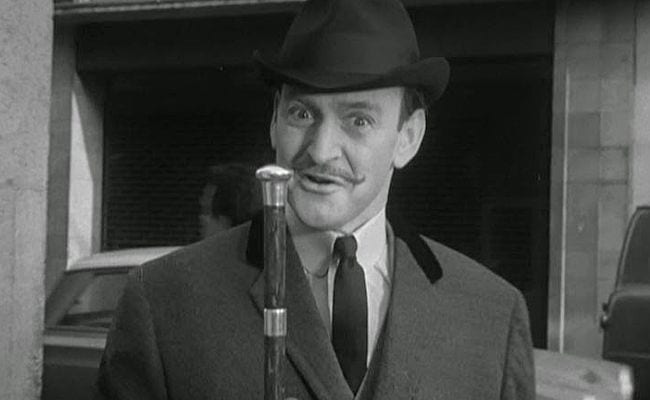
With the success of MGM’s made-in-England series of Miss Marple movies starring Margaret Rutherford, producer Lawrence P. Bachmann thought it auspicious to try Agatha Christie’s other famous detective, the Belgian sleuth Hercule Poirot. If he hoped for another series, the plan didn’t get beyond one movie, which is now available on demand from Warner Archive.
Like the Marple films, The Alphabet Murders is more of a comic lark that diverges in tone and plot from Christie. Indeed, it goes farther, seeming to parody Poirot films almost before they existed. The spoofiness is signaled right away as Tony Randall addresses the camera as himself before transforming into Poirot and addressing the camera some more. It’s all a joke, and this approach didn’t please Christie or mystery fans, nor even fans of Randall.
The appeal is to fans of director Frank Tashlin, for this is above all a Tashlin film. This extends to the casting of Randall, who starred in Tashlin’s arguably great Will Success Spoil Rock Hunter?. (Zero Mostel had been first choice for Poirot but didn’t like the script, according to TCM’s Richard Harland Davis.) Tashlin was a cartoon director who navigated a successful feature career by applying his wacky visual ideas and fast pacing to Bob Hope movies, two hits with Jayne Mansfield (including The Girl Can’t Help It), and several Jerry Lewis films, mentoring Lewis’ own directorial style.
From the beginning of The Alphabet Murders, Tashlin pushes a zany, even bizarre series of self-conscious gags at the audience, like the alternating close-ups of Poirot and Captain Hastings (here a corpulent secret agent played by Robert Morley) speaking in front of a double-sided mirror that reflects his own mouth upon the other’s face, or the moment when aquarium fish seem to be speaking. This is very much a cartoon world, with a silly story that includes the murders of an acrobat and a bowling instructor (Grazina Frame). In keeping with Tashlin’s emphasis on spectacle over sense, transitions are sometimes skipped in a manner that makes the plot seem random, and we can’t help wondering if Tashlin altered the script by Marple writers David Pursall and Jack Seddon.
The movie’s other wild card is Anita Ekberg, who plays not so much a character as a mischievous plot device — essentially a human cartoon. Her schizophrenic heroine pops in and out of the story, claiming to be responsible for an alphabetical series of killings and then perversely teasing Poirot with denials and trickery. Only when the mystery is explained does it become clear how idiotic this is, but the whodunit plot is meant to be taken no more seriously than anything else in this bonbon. It’s indirectly a spy spoof, as per the order of the day, and Tashlin would emphasize that element in his two Doris Day vehicles, The Glass Bottom Boat and Caprice. Those aren’t great either, but again, Tashlin’s touch comes through.
A meticulous restoration would surely make Desmond Dickinson’s black-and-white photography of London locations more scintillating, but who’s going to undertake that? As with the Marples, jaunty music is provided by Ron Grainer, this time with a Gallic accordion flavor. The nonsensical proceedings are supported by solid character players in Maurice Denham, Guy Rolfe, Sheila Allen, James Villiers, Julian Glover, Clive Morton, Cyril Luckham, and Richard Wattis. Margaret Rutherford and Stringer Davis make cameos as their characters from the Marple films. A more “inside baseball” wink is the presence of Austin Trevor, who played Poirot in three forgotten British films of the early ’30s. The trailer is included.


![Call for Papers: All Things Reconsidered [MUSIC] May-August 2024](https://www.popmatters.com/wp-content/uploads/2024/04/all-things-reconsidered-call-music-may-2024-720x380.jpg)



